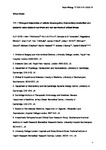Divergent trajectories of cellular bioenergetics, intermediary metabolism and systemic redox status in survivors and non-survivors of critical illness
| dc.contributor.author | McKenna, Helen | |
| dc.contributor.author | O’Brien, KA | |
| dc.contributor.author | Fernandez, BO | |
| dc.contributor.author | Minnion, M | |
| dc.contributor.author | Tod, A | |
| dc.contributor.author | McNally, BD | |
| dc.contributor.author | West, JA | |
| dc.contributor.author | Griffin, JL | |
| dc.contributor.author | Grocott, MP | |
| dc.contributor.author | Mythen, MG | |
| dc.contributor.author | Feelisch, M | |
| dc.contributor.author | Murray, AJ | |
| dc.contributor.author | Martin, Daniel | |
| dc.date.accessioned | 2021-03-04T11:43:29Z | |
| dc.date.available | 2021-03-04T11:43:29Z | |
| dc.date.issued | 2021-05 | |
| dc.identifier.issn | 2213-2317 | |
| dc.identifier.issn | 2213-2317 | |
| dc.identifier.other | 101907 | |
| dc.identifier.uri | http://hdl.handle.net/10026.1/16921 | |
| dc.description.abstract |
BACKGROUND: Numerous pathologies result in multiple-organ failure, which is thought to be a direct consequence of compromised cellular bioenergetic status. Neither the nature of this phenotype nor its relevance to survival are well understood, limiting the efficacy of modern life-support. METHODS: To explore the hypothesis that survival from critical illness relates to changes in cellular bioenergetics, we combined assessment of mitochondrial respiration with metabolomic, lipidomic and redox profiling in skeletal muscle and blood, at multiple timepoints, in 21 critically ill patients and 12 reference patients. RESULTS: We demonstrate an end-organ cellular phenotype in critical illness, characterized by preserved total energetic capacity, greater coupling efficiency and selectively lower capacity for complex I and fatty acid oxidation (FAO)-supported respiration in skeletal muscle, compared to health. In survivors, complex I capacity at 48 h was 27% lower than in non-survivors (p = 0.01), but tended to increase by day 7, with no such recovery observed in non-survivors. By day 7, survivors' FAO enzyme activity was double that of non-survivors (p = 0.048), in whom plasma triacylglycerol accumulated. Increases in both cellular oxidative stress and reductive drive were evident in early critical illness compared to health. Initially, non-survivors demonstrated greater plasma total antioxidant capacity but ultimately higher lipid peroxidation compared to survivors. These alterations were mirrored by greater levels of circulating total free thiol and nitrosated species, consistent with greater reductive stress and vascular inflammation, in non-survivors compared to survivors. In contrast, no clear differences in systemic inflammatory markers were observed between the two groups. CONCLUSION: Critical illness is associated with rapid, specific and coordinated alterations in the cellular respiratory machinery, intermediary metabolism and redox response, with different trajectories in survivors and non-survivors. Unravelling the cellular and molecular foundation of human resilience may enable the development of more effective life-support strategies. | |
| dc.format.extent | 101907-101907 | |
| dc.format.medium | Print-Electronic | |
| dc.language | en | |
| dc.language.iso | en | |
| dc.publisher | Elsevier BV | |
| dc.subject | Critical illness | |
| dc.subject | Stress physiology | |
| dc.subject | Energy metabolism | |
| dc.subject | Mitochondria | |
| dc.subject | Redox signaling | |
| dc.subject | Oxidative stress | |
| dc.title | Divergent trajectories of cellular bioenergetics, intermediary metabolism and systemic redox status in survivors and non-survivors of critical illness | |
| dc.type | journal-article | |
| dc.type | Journal Article | |
| dc.type | Research Support, Non-U.S. Gov't | |
| plymouth.author-url | https://www.webofscience.com/api/gateway?GWVersion=2&SrcApp=PARTNER_APP&SrcAuth=LinksAMR&KeyUT=WOS:000646237600001&DestLinkType=FullRecord&DestApp=ALL_WOS&UsrCustomerID=11bb513d99f797142bcfeffcc58ea008 | |
| plymouth.volume | 41 | |
| plymouth.publication-status | Published | |
| plymouth.journal | Redox Biology | |
| dc.identifier.doi | 10.1016/j.redox.2021.101907 | |
| plymouth.organisational-group | /Plymouth | |
| plymouth.organisational-group | /Plymouth/Faculty of Health | |
| plymouth.organisational-group | /Plymouth/Faculty of Health/Peninsula Medical School | |
| plymouth.organisational-group | /Plymouth/REF 2021 Researchers by UoA | |
| plymouth.organisational-group | /Plymouth/REF 2021 Researchers by UoA/UoA01 Clinical Medicine | |
| plymouth.organisational-group | /Plymouth/Users by role | |
| plymouth.organisational-group | /Plymouth/Users by role/Academics | |
| plymouth.organisational-group | /Plymouth/Users by role/Researchers in ResearchFish submission | |
| dc.publisher.place | Netherlands | |
| dcterms.dateAccepted | 2021-02-16 | |
| dc.rights.embargodate | 2021-3-10 | |
| dc.identifier.eissn | 2213-2317 | |
| dc.rights.embargoperiod | Not known | |
| rioxxterms.versionofrecord | 10.1016/j.redox.2021.101907 | |
| rioxxterms.licenseref.uri | http://www.rioxx.net/licenses/all-rights-reserved | |
| rioxxterms.licenseref.startdate | 2021-05 | |
| rioxxterms.type | Journal Article/Review |


